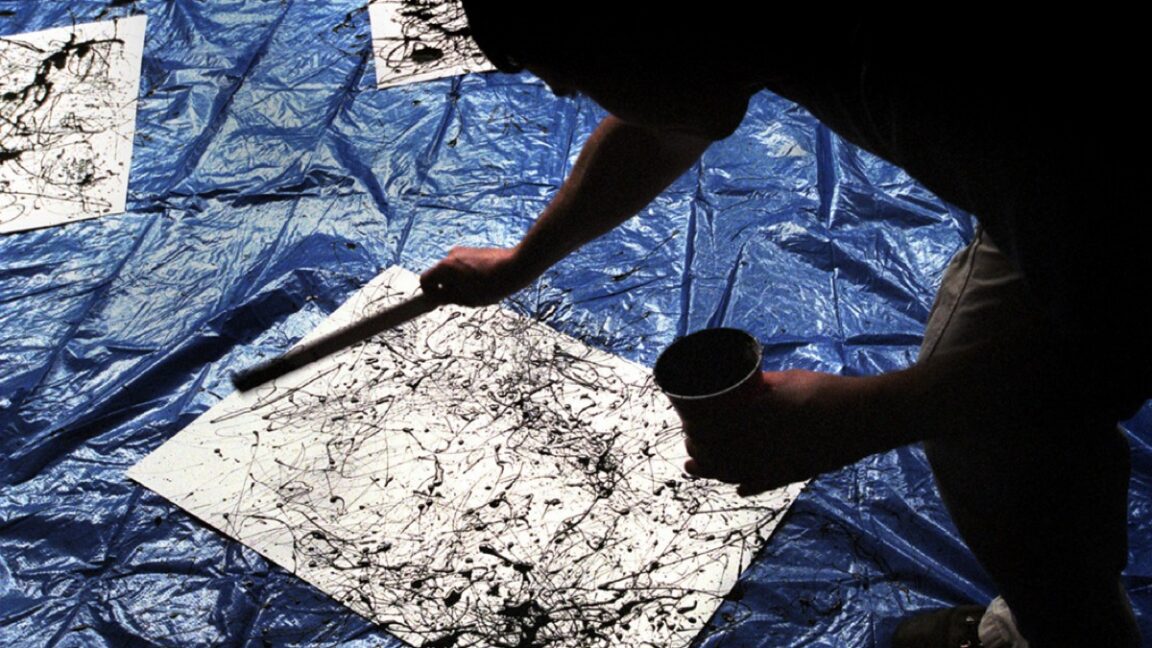Science
Study Reveals Kids’ Art Closely Mirrors Pollock’s Techniques

A recent study has found that children’s drip paintings resemble the work of renowned artist Jackson Pollock more closely than those created by adults. This intriguing conclusion arises from an analysis of splatter paintings through a fractal lens, providing fresh insights into both the nature of children’s art and the physics underlying Pollock’s iconic style. The research, published in the journal Frontiers in Physics, was co-authored by physicist Richard Taylor from the University of Oregon.
Taylor’s interest in Pollock’s work dates back to 2001, when he first identified fractal patterns in Pollock’s seemingly chaotic drip techniques. His initial findings sparked considerable debate among art historians and physicists alike. A controversial 2006 study by Case University researchers Katherine Jones-Smith and Harsh Mathur criticized Taylor’s methodology, claiming it lacked the necessary range of scales to be considered fractal. Despite this, Taylor’s work gained substantial traction, leading to a 2015 study that achieved a 93 percent accuracy rate in distinguishing genuine Pollocks from forgeries. His latest research in 2024 boasts an impressive 99 percent accuracy.
Pollock’s unique approach to painting involved laying a canvas flat on the ground and pouring paint from various tools, including cans, sticks, and syringes. This technique resulted in a dynamic interplay of textures and colors, a process that Taylor suggests may have been influenced by Pollock’s own physical limitations, particularly his clumsiness. “Pollock was notoriously clumsy,” Taylor noted, emphasizing how this trait may have inadvertently contributed to the fractal quality of his work.
Examining Artistic Techniques Through Fractals
In the latest study, Taylor and his team examined the splatter paintings created by 18 children aged four to six and 34 adults aged 18 to 25. The age difference was critical, as it allowed the researchers to study significant variations in biomechanical balance development across these two groups. The analysis focused not only on the fractal dimensions of the paintings but also on “lacunarity,” which measures the gaps between paint clusters.
The results indicated that adult paintings exhibited higher paint densities and more varied trajectories than those of the children. In contrast, the children’s work displayed simpler one-dimensional patterns with fewer changes in direction. “While both groups had coarse-scale motions, the children’s fine-scale structures were clumpy, unlike the uniformity seen in adult works,” Taylor explained.
The research also compared the paintings of Pollock with those of Max Ernst, whose method involved using a controlled pendulum for painting. Interestingly, Ernst’s work displayed fractal dimensions similar to those of the children, suggesting a contrast to Pollock’s free-flowing style.
Future Research Directions and Implications
Taylor acknowledges that while this study highlights differences in balance and artistic output, direct measurements of the subjects’ biomechanical balance during painting were not conducted. Future iterations of the study will involve motion sensors to provide a more comprehensive understanding of how physical movements influence the resulting art.
This research opens avenues for further exploration into the relationship between artistic technique and physicality, not just for Pollock but across various artists employing drip or pouring methods. Taylor’s ongoing work aims to deepen the understanding of how fractal dimensions and lacunarity manifest in different artistic styles.
By illuminating the connections between children’s art and Pollock’s masterpieces, this study not only challenges prevailing assumptions about artistic capability but also enhances appreciation for the intricate interplay of physics and creativity in the world of art.
-

 Science3 months ago
Science3 months agoToyoake City Proposes Daily Two-Hour Smartphone Use Limit
-

 Top Stories3 months ago
Top Stories3 months agoPedestrian Fatally Injured in Esquimalt Collision on August 14
-

 Health3 months ago
Health3 months agoB.C. Review Reveals Urgent Need for Rare-Disease Drug Reforms
-

 Technology3 months ago
Technology3 months agoDark Adventure Game “Bye Sweet Carole” Set for October Release
-

 World3 months ago
World3 months agoJimmy Lai’s Defense Challenges Charges Under National Security Law
-

 Lifestyle3 months ago
Lifestyle3 months agoVictoria’s Pop-Up Shop Shines Light on B.C.’s Wolf Cull
-

 Technology3 months ago
Technology3 months agoKonami Revives Iconic Metal Gear Solid Delta Ahead of Release
-

 Technology3 months ago
Technology3 months agoApple Expands Self-Service Repair Program to Canada
-

 Technology3 months ago
Technology3 months agoSnapmaker U1 Color 3D Printer Redefines Speed and Sustainability
-

 Technology3 months ago
Technology3 months agoAION Folding Knife: Redefining EDC Design with Premium Materials
-

 Business3 months ago
Business3 months agoGordon Murray Automotive Unveils S1 LM and Le Mans GTR at Monterey
-

 Technology3 months ago
Technology3 months agoSolve Today’s Wordle Challenge: Hints and Answer for August 19









